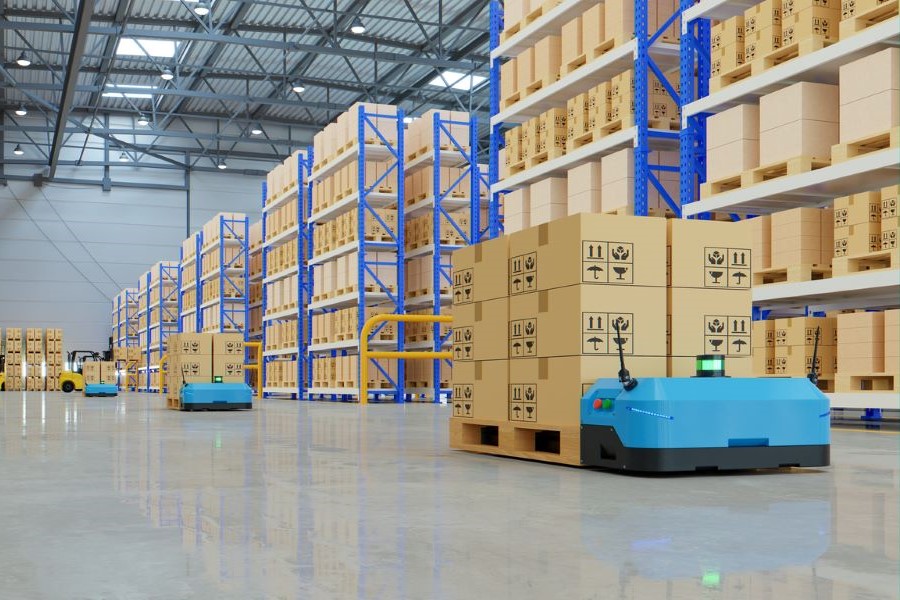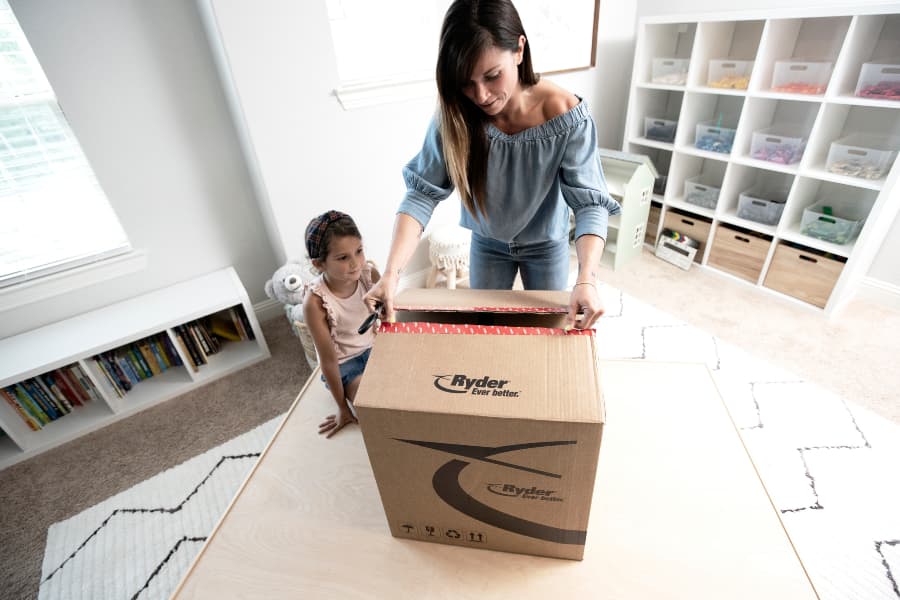Amid the rise in e-commerce and consumer demand for speedy delivery, efficient, fast order preparation has become a necessary core competency for businesses that want to remain competitive. The most effective way to meet this challenge is warehouse automation, which transforms goods-to-person delivery.
Traditionally, the goods-to-person system required complex, clunky retrieval systems using shuttle carts, roller conveyors, and stack cranes. Today, warehouse robots deliver products directly to workers at their pick stations, reducing movement and errors and saving time while increasing facility efficiency.
The result? A more optimized warehouse environment meets deadlines, creates a safer work environment, and improves flexibility, communication, and customer satisfaction. With third-party logistics provider (3PL) guidance, your company can harness the advantages of automated warehouse robots to improve warehouse efficiency and supply chain management to reach a new level of success.
In this article, we’ll explore the different types of goods-to-person automation, its benefits, how it optimizes warehouse functions, some examples of effective implementation, and the role of 3PLs.
Types of goods-to-person warehouse automation
There’s more than one type of goods-to-person technology, and it is vital to find the right fit based on your operation’s SKU, order profiles, facility characteristics, labor utilization, and overall business objectives.
Automated storage and retrieval systems (AS/RS)
This type of system modernizes of the traditional method with warehouse automation technology that can incorporate shuttles, cranes, robots, vertical carousels, micro-loads, unit-loads, stockers, and other systems. These components are usually integrated with warehouse management system software.
Automated guided vehicles (AGVs)
AGVs are automated, driverless robots that use lasers, cameras, floor markers, wires, or magnets to travel around your warehouse. By executing formerly labor-intensive tasks like order picking and product handling, they can be integrated with warehouse management or ERP systems to provide central control and real-time inventory tracking. They require little infrastructure, and can be used in conjunction with other systems to optimize operations.
Autonomous mobile robots (AMRs)
An AMR is a robot that can operate in your warehouse without human supervision. They use sensors and maps to navigate your warehouse. Unlike other systems, AMRs can guide and help workers while transporting product.
Vertical lift modules ( VLMs)
VLMs can help optimize vertical cube storage. Product stored in trays are delivered directly to the worker. After picking, the trays are automatically returned and the next is retrieved.
Goods-to-person workstations
Goods-to-person workstations are fixed locations designed with ergonomics in mind. They facilitate speedy order completion as they are fed product.
The benefits of goods-to-person automation
Goods-to-person automation involves more than technology. It’s a strategy with myriad benefits that can completely transform and optimize warehouse efficiency and supply chain management. It also increases customer satisfaction in the following ways:
- Efficiency improves when goods are brought directly to the operators, eliminating manual order picking for faster fulfillment.
- Labor costs decrease when warehouse robots do the heavy lifting means higher productivity and a staff that handles more value-added tasks.
- Errors are reduced in picking operations, preventing sending the wrong item or shipping to the wrong location.
- Scalability is a major automation advantage that manages seasonal peaks and long-term growth, automated systems meet your needs without hiring or laying off personnel.
- Optimize space by installing robots and autonomous vehicles that can operate in narrow aisles and reach high shelves to maximize vertical storage.
- Productivity and throughput increase with automation -- manual order picking can consume 70% of worker time, per SupplyChain247.com, but robots and related technology increase the speed and efficiency of moving inventory from stock locations.
Automation allows higher worker satisfaction and safety through reducing manual lifting and walking.
Goods-to-person automaton optimizes warehouse functions
Goods-to-person automation also gives warehouse operations efficiency a boost. In addition to minimizing errors and reducing travel time, it offers:
- Real-time inventory visibility: Equipped with state-of-the-art software and sensors, automation systems provide real-time visibility into levels and movement of inventory. Stock tracking is accurate, expiration dates can be monitored, and replenishment managed.
- Data-generated decisions: This reduces stockouts and overstocking and their associated costs. Demand forecasting is more accurate; you can optimize inventory levels and improve the responsiveness of your supply chain.
- Sorting: Robotic sorting technology allows warehouses to operate efficiently and accurately, using precision algorithms that reduce human error. Manual, repetitive, time-consuming, and expensive processes are streamlined.
- Packing: Warehouse automation decreases packing time and associated labor costs. Robots and other systems can identify palletized objects, which improves order completion times with greater accuracy.
Address labor shortages
Supply chain management can be one big headache. There are material shortages and shipping delays, and labor is increasingly hard to find. Per Freightwaves, the lack of workers and retention challenges present the biggest supply chain concerns. The article points out that investments in technology will be crucial to attract talent.
Goods-to-person automation offers a robust solution to labor shortages. Warehouse workers risk injury from repetitive and demanding physical tasks. Fortunately, robots are excellent at these activities and can perform them better and faster.
This evolution creates a more attractive work environment. Robots and other automation make warehouses safer and the work more interesting. However, automation requires retraining and upskilling your workforce. Here are a few points to consider:
- New machinery can mean higher potential for injury. Make sure everyone is trained to do their jobs safely, from pickers and packers to managers.
- Cross-train mechanics and technicians to maintain and repair machinery. Most warehouse equipment manufacturers offer training on maintaining their equipment.
- Train team leaders to be project managers. They are qualified to manage people and are line-of-business experts.
- Logistic compliance teams will need upgraded skills to keep pace with automation. There are entirely new labor and technology laws.
Implement goods-to-person automation with a 3PL
A 3PL supports your supply chain, and runs your pick, pack, and ship process so you don’t have to. Supply chains are complicated; partnering with a 3PL means you don’t have to invest time in becoming a supply chain expert. Also, 3PLs mean lower costs, saving time, and creating a smoother-running supply chain. From warehousing to inventory management to picking, packing, shipping, and returns, they can help you do it all.
You also gain expertise and technology; 3PLs have specialized knowledge and advanced technology systems to manage complex logistical operations. Innovative businesses leverage that expertise to gain a competitive edge.
What type of warehouse automation you implement in your warehouse can present a conundrum. A 3PL will be able to assess whether your company is ready for automation and what customized solution will give you the best ROI and easily integrate with legacy systems. Any 3PL worth its salt will also offer maintenance and support.
How Ryder can successfully implement goods-to-person automation
Ryder works with warehouse automation equipment and system manufacturers to implement technology that makes the most sense for an operation. One of these technologies is AutoStore™, an automated storage and retrieval system. AutoStore gives supply chains speed and reliability while increasing storage capacity with an automated system that fulfills orders 24/7.
Implementing RyderShare and AutoStore technology gives visibility to healthcare companies, improves fill rates, and maximizes efficiency. These factors are not present within a distributor model.
A great example is Ryder's solution for BJC Healthcare, which serves 14 facilities with more than 3,200 beds. Ryder found a centralized location for the warehouse to serve the entire network. The more than 400,000 sq. ft. ambient temperature facility was designed from the ground up and includes 1.3 miles of conveyors, 44 dock doors, and houses 17,000 SKUs. The warehouse is a central supply center that includes medical devices, pharmaceuticals, and day-to-day supplies and includes automation and proprietary technology platforms.
The result? Prior to Ryder, BJC had a 90% fill rate. Six months after going live, Ryder improved that fill rate to 98%. BJC Healthcare’s level of service improved by 40%, and the cost per PO dropped by one-third.
This means the products are available for clinicians to care for their patients when needed. Ryder brought together the complete package with automation, which facilitates success.
Harness all the benefits of goods-to-person automation
Goods-to-person automation saves money, time, and effort. It reduces errors, optimizes space, and provides a practical solution for labor shortages that impact supply chain and warehouse management.Tech upgrades fuel business growth for those who embrace it. The future offers more ways to optimize supply chains: artificial intelligence, the Internet of Things, and embedded analytics. It’s time to optimize.




